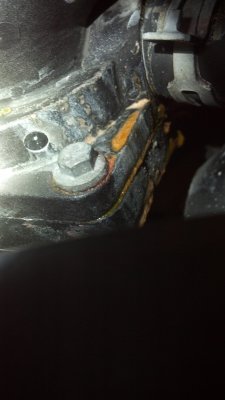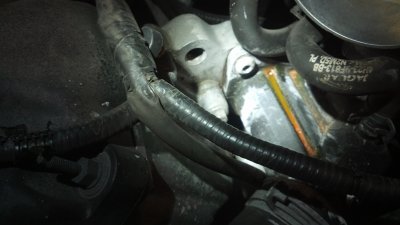At least that is what my kids thought. It is actually the radiator fluid leaking, concentrating and burning in the engine bay.
I am not losing a lot of fluid. Long story short - I thought one of my belts or pulleys was going bad, it turned out to be radiator fluid dripping on the belts and the belts and pulley was consequently making noise.
After replacing both pulleys, belts, etc I realized it was the leak. I tightened the hoses, but there is still some fluid escaping. I will probably replace the upper radiator hoses as a precaution, but from these photos you can see where it is pooling - and also **** around a fitting on the thermostat assembly.
Questions:
1. How hard is the thermostat assembly to replace (I did all the belts and pulleys previously, so I am not afraid to get in there)
2. Does anyone have thoughts on location of leak? It appears to be the thermostat assembly or some other hose close by. It only seems to push out fluid when under stress or driving, so if I clean it up there is no dripping when engine is just running in the garage.
http://www.partsgeek.com/catalog/2005/land_rover/lr3/cooling_system/thermostat_assembly.html
Upper assembly here:
http://www.partsgeek.com/catalog/2005/land_rover/lr3/cooling_system/radiator_hose.html
First photo shows coupling built into the thermostat. The only piece of the thermostat you can see in the new thermostat linked where there are two plates coupled together - the part photo shows holes for bolts but no actual bolts in the part photo.
Second photo is just a recessed area on the thermostat where it is catching some fluid. I don't know if the fluid is getting pushed out of the thermostat itself, or just collecting there from a hose link in the area?
I am not losing a lot of fluid. Long story short - I thought one of my belts or pulleys was going bad, it turned out to be radiator fluid dripping on the belts and the belts and pulley was consequently making noise.
After replacing both pulleys, belts, etc I realized it was the leak. I tightened the hoses, but there is still some fluid escaping. I will probably replace the upper radiator hoses as a precaution, but from these photos you can see where it is pooling - and also **** around a fitting on the thermostat assembly.
Questions:
1. How hard is the thermostat assembly to replace (I did all the belts and pulleys previously, so I am not afraid to get in there)
2. Does anyone have thoughts on location of leak? It appears to be the thermostat assembly or some other hose close by. It only seems to push out fluid when under stress or driving, so if I clean it up there is no dripping when engine is just running in the garage.
http://www.partsgeek.com/catalog/2005/land_rover/lr3/cooling_system/thermostat_assembly.html
Upper assembly here:
http://www.partsgeek.com/catalog/2005/land_rover/lr3/cooling_system/radiator_hose.html
First photo shows coupling built into the thermostat. The only piece of the thermostat you can see in the new thermostat linked where there are two plates coupled together - the part photo shows holes for bolts but no actual bolts in the part photo.
Second photo is just a recessed area on the thermostat where it is catching some fluid. I don't know if the fluid is getting pushed out of the thermostat itself, or just collecting there from a hose link in the area?
Attachments
Last edited:



